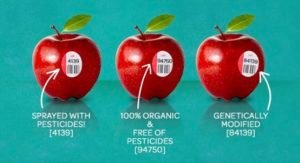There is a huge debate going on out there about GMO food products. There are some easy tricks that can help you find which foods are natural and which ones are not.
Jason Calton is one of the leading voices that have raised concerns against genetically modified products. He is a dietician from Yale and Harvard Universities, and has co-authored “Rich Food, Poor Food” in which he emphasizes the hazards of using genetically modified products.
According to Calton, commercially produced foods such as fish, meat, and milk are mostly sourced from animals which are fed GMO foods. But he also provides ways to identifying such foods including veggies and fruits.
Product Lookup Number
The first trick is to check the Product Lookup Number (PLU) on the product label. If you notice that this 4-digit number starts with ¾, it is a sign that the food is not genetically modified. But it does mean that the food has been sourced from a farm where various types of chemicals were used.
If you find the number to have 5 digits, staring with 9, it indicates that the food is organic and doesn’t have any GMO or chemicals. It is the kind of food you should be buying.
If the food product has a 3 digit number that starts with 8, it is a clear sign that it is genetically modified product.

Challenges with GMO Products
Despite this method of identification of GMO food products, it is still difficult to identify them generally. They are produced more commonly and may not be labeled in many cases. So there is no 100% assurance that you could avoid them entirely. But there are fruits and veggies which are not usually modified. Some good bets include mangoes, avocadoes, pineapples, melons, watermelons, grapefruits, kiwis, onions, eggplants, beans, cabbages, mushroom, and sweet potatoes.
At the other end of the spectrum are apples, grapes, strawberries, blueberries, peaches, oranges, cherries, peppers, cucumbers, spinach, nectarines, kale, green beans, corn and potatoes, which are highly likely to be genetically modified.
But the good thing with fruits and veggies is that there are signs that help you identify whether they are genetically modified or not. For example, if you press a tomato gently and you notice marks, there’s a good chance that it is genetically modified.
As a general rule, look for fruits / veggies that don’t seem to be perfect in their looks. There’s a good chance that they are not genetically modified, but are healthy.
Buy From Farmers
You could purchase foods directly from farmers who are growing fruits / veggies organically. If it’s not possible, buy food from stores that doesn’t come with packaging. Packaging is usually used by GMO food producers because they rake in more profits and can afford to offer them. So one good strategy could be to avoid fresh produce that is packaged beautifully.